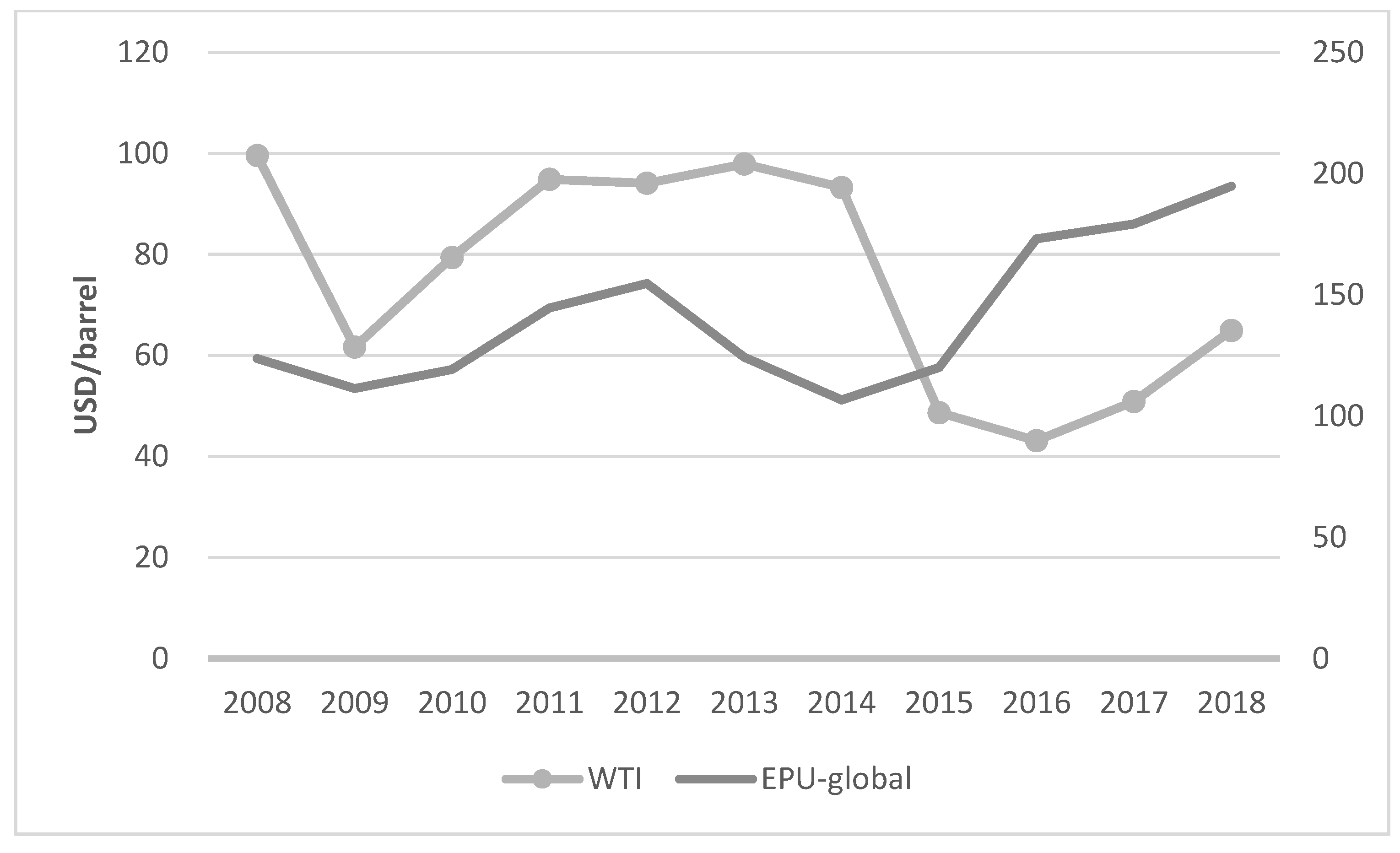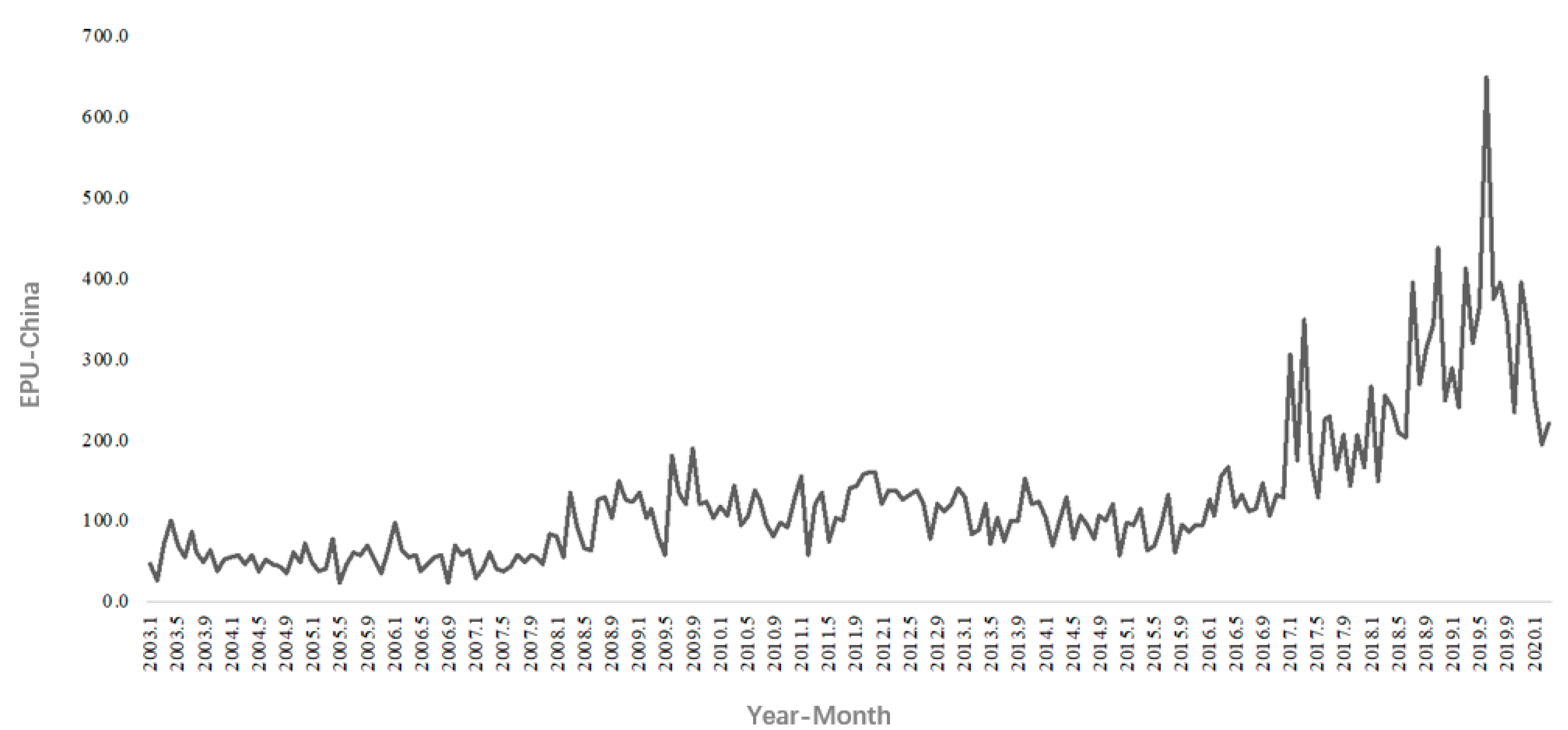3.1. Research Design and Model Construction
This paper studies the impact of EPU on RTFEP, mainly including two aspects: one is to estimate the impact of EPU on RTFEP; the second is to verify the mechanism of the influence of EPU on RTFEP. Therefore, this section focuses on these two aspects in describing the research design.
- (1)
Effect estimation of EPU on RTFEP
EPU belongs to the economic index at the macrolevel, while RTFEP is at the regional level. Therefore, this paper chooses to build a prefecture-level econometric model to estimate the impact of EPU on RTFEP. The model is as follows:
In Equation (1), the interpreted variableis the total-factor energy productivity in yearof city ; the core explanatory variable is the economic policy uncertainty in yearof city ; is the control variable; is the time trend effect (because the explanatory variables of economic policy uncertainty only change in time, time fixed effects are replaced by time trends to control the effects of unobservable factors that change over time); is the regional fixed effect; and is the error term.
- (2)
Mechanism verification of EPU on RTFEP
This paper will verify the mechanism of EPU affecting RTFEP from the perspective of the energy market adjustment mechanism and government administrative intervention.
(a) Energy market regulation
EPU will have an impact on RTFEP by affecting energy prices and changing the structure of energy consumption.
In Equation (2), the interpreted variableis the energy prices and energy consumption structure in yearof city ; the core explanatory variable is the economic policy uncertainty in yearof city ; is the control variable; is the time trend effect; is the regional fixed effect; and is the error term.
(b) Government economic intervention
Facing the macroeconomic recession accompanied by economic policy uncertainties, the government will stimulate economic growth through the introduction of expansionary fiscal policies. The negative externalities of the policies will have an impact on the region’s overall energy productivity.
In Equation (3), the interpreted variableis the government intervention in yearof city ; the core explanatory variable is the economic policy uncertainty in yearof city ; is the control variable; is the time trend effect; is the regional fixed effect; and is the error term.
3.2. Variable Measurement and Data Sources
- (1)
Core explanatory variables
The core explanatory variable of this paper is economic policy uncertainty. Baker, Bloom, Davis, and Wang constructed the China economic policy uncertainty index in 2013 (the China economic policy uncertainty index compiled by Baker et al. was completed in 2013 and published in the 4th
Quarterly Journal of Economics in 2016) [
3,
31,
32]. The index is based on the Hong Kong English newspaper
South China Morning Post. The frequency of articles about uncertainties in China’s economic policy eventually resulted in a monthly index of uncertainty in China’s economy. On this basis, Davis et al. took the
People’s Daily and
Guangming Daily as the analysis objects and developed the China economic policy uncertainty index based on mainland newspapers (data source:
http://policyuncertainty.com/china_epu.html) (accessed on 1 December 2020). Since the research object of this paper is the prefecture-level cities in China’s interior, the economic policy uncertainty index based on mainland newspapers that better reflects the development of the central government’s economic policies was selected and was divided by 100 as the explained variable in this article. As shown in
Figure 3, the China economic policy uncertainty index has shown an overall upward trend from 2003 to 2017. Specifically, EPU increased slightly from 2008 to 2016 and increased significantly from 2017 to early 2020. Therefore, it is necessary to study the impact of economic policy uncertainty on regional economic development.
From the measurement method of economic policy uncertainty, it can be seen that economic policy uncertainty is a macroindicator at the national level, reflecting the fluctuation and stability of the whole country’s economic policy. It can be considered that the macroeconomic uncertainty of a country’s economic policy is exogenous to the energy productivity of specific areas within the country. Therefore, choosing the economic policy uncertainty index of Baker et al. can better avoid the possible endogenous problem in the estimation. This indicator of economic policy uncertainty is also widely used to analyze the impact on the regional economy [
13], corporate cash holdings [
33], and the economic cycle [
34].
- (2)
Explained variables
The explained variable in this paper is the regional total-factor energy productivity. The existing research has various methods for measuring energy productivity. According to the factors of input and output, they can be divided into single-factor indicators and total-factor indicators. At the same time, different measurement methods also reflect the differences in economic growth methods based on energy factors. The single-factor indicator is a partial-factor indicator reflecting the relationship between energy consumption and effective output in economic activities [
35] and is usually measured by the energy consumption intensity per unit of GDP. Shi [
36] used the reciprocal of energy consumption intensity to measure energy productivity and analyzed the regional differences in energy productivity and energy-saving potential in China. The calculation of single-factor indicators is simple, and it is also convenient for country comparison, but it cannot reflect the substitution effect of production factors such as labor and capital on energy, resulting in the problem of exaggerated energy productivity [
37]. Yang and Shi [
38] compared single-factor and total-factor energy efficiency indicators and found that the energy efficiency indicators measured by different total-factor methods have stronger consistency, and at the same time, total-factor indicators can better reflect the input of factors in various regions so as to make a more scientific and reasonable explanation of the utilization of energy productivity. From the perspective of economic growth, the accumulation of factors and the improvement of productivity are the two main sources of economic growth [
39]. Economic growth is generally divided into two types: one is the growth achieved by increasing the input of natural resources, capital, and labor, and the other is achieved by improving the production efficiency [
40]. Therefore, the way of measuring energy productivity by taking energy as a single input factor essentially reflects the extensive economic growth mode driven mainly by factor input.
Therefore, in order to make up for the shortcomings of the single-factor index, more and more scholars have begun to use the total-factor index for measurement. Hu and Wang [
37] pioneered the use of data envelopment analysis (DEA) to measure the total-factor energy productivity of 29 provinces and municipalities in China. Among them, the input variable is labor, capital, energy consumption, and biomass energy, and the output variable is GDP. Subsequently, Zeng et al. [
8,
41], and Li and Huo [
42] also used DEA to measure and analyze China’s energy productivity. The calculation method of the total-factor index considers that the increase in energy productivity comes from the productivity contribution of multiple input factors rather than the contribution of the accumulation of single input factors. This reflects the direction of economic growth towards intensive change to some extent.
However, although this method incorporates labor and capital factors into the DEA model, it does not take into account the impact of undesirable output from energy consumption on energy productivity. Later, Yuan et al. [
43], Wang et al. [
44], Yeh et al. [
45], and Xu and Guan [
46] used pollutants as an input, converted it into a desired output by taking the reciprocal or multiplying by “−1”, and calculated the total-factor energy productivity based on the Shephard distance function. However, this kind of treatment of pollutants is contrary to the actual production process, and it also will damage the convexity requirements of the model [
35]. In order to solve this problem, Tone [
47] incorporated slack variables into the objective function and constructed a non-radial and non-angle SBM model. This model not only solves the non-efficiency problem caused by input slack but also avoids deviations caused by radial and angular selection. Moreover, Tone [
48] has further improved the model, incorporated undesirable output (environmental pollution) into the evaluation system, and comprehensively measured energy productivity from multiple inputs and multiple outputs and angles. The way of incorporating pollutants into the energy productivity calculation model is based on intensive economic growth, which further considers the importance of green development for economic growth and is an important performance of sustainable economic growth.
This paper believes that energy productivity is an important representation of the regional economic growth mode. In the context of current high-quality economic development, it is necessary to consider the total-factor energy productivity under the input of multiple factors and the negative impact of undesirable output on economic growth. In this paper, the DEA-SBM method taking environmental pollution into account will be used as the main measure of regional energy productivity, and the differences between the single-factor and traditional DEA approach will also be compared.
This paper uses three methods to measure the energy productivity of 281 prefecture-level cities (due to the lack of data, this article eliminated 12 out of 293 prefecture-level cities in China, including: Chaohu City in Anhui Province, Sansha City and Danzhou City in Hainan Province, Haidong City in Qinghai Province, and Turpan City and Hami City in Xinjiang Uygur Autonomous Region and Tibet Autonomous Region (Lhasa, Shigatse, Changdu, Nyingchi, Shannan, Naqu)) and 4 municipalities in China from 2003 to 2017.
(a) Single-factor energy productivity
The indicator uses energy consumption as an input variable and GDP as the output. It is measured by GDP divided by energy consumption (i.e., the reciprocal of energy intensity). In order to facilitate comparison with the other two methods, the results were normalized (divided by the maximum value). The energy consumption is the annual electricity consumption (10,000 kw/h); liquefied petroleum gas (ton) and gas (10,000 m3) were converted into the unit of 10,000 tons of standard coal, and then we summed them and took the logarithm. In order to eliminate the influence of price factors, the consumer price index (CPI) based on 2003 was used to deflate GDP and take the logarithm. The data of energy consumption and GDP come from the China City Statistical Yearbook, and the CPI comes from the National Bureau of Statistics of China.
(b) Total-factor energy productivity based on DEA–Malmquist model
DEA is a non-parametric test method developed on the basis of the concept of relative efficiency evaluation. It can be divided into three types: The CCR model, BCC model, and DEA–Malmquist model. The first two types are constant returns to scale and variable returns to scale which belong to the traditional DEA model and can only horizontally compare the production efficiency of DMUs at the same time point. The DEA–Malmquist index model can measure the dynamic changes in the production efficiency of DMUs in different periods, so we chose the DEA–Malmquist index model to measure the total-factor energy productivity.
The explained variable in this paper:
In Equation (4), , , represent input, expected output, and undesired output elements; is the objective function; represents the input vector of the weight of the input elements; , represent the slack vectors of each input, expected output, and undesired output; , , represent the number of inputs, expected output, and undesired output, respectively. The more slack in the constraints on input and output, the lower the efficiency value of DMUs; when the slack vectors are all 0, the efficiency value of DMUs equals to 1, which means that the DMUs are valid, otherwise they are invalid and the input and output need to be improved to achieve optimal efficiency.
The three energy productivity measurement methods (
Table 1) in this paper are summarized as follows.









